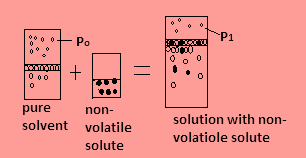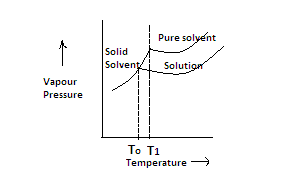Answer
395.7k+ views
Hint: When non-volatile solute is added in solvent, a solution is formed. The vapour pressure of the solution decreases and the substance present in larger amounts solidifies when vapour pressure of solid becomes equal to the vapour pressure of liquid.
Complete step by step answer:
-When a non-volatile solute is added in a pure solvent, some solute molecules occupy the surface area along with molecules of pure solvent and the pure solvent’s tendency to go into vapour phase decreases due to which the vapour pressure of solution decreases. This means that the vapor pressure of solid and liquid solvent becomes equal at lower temperature. This is called the depression in the freezing point.
-Let us take example –

Suppose in the closed container, water is the pure solvent in the figure and its freezing point is \[{0^ \circ }{\text{C}}\] and water’s vapour pressure is suppose ${{\text{P}}_0}$ as evaporation at the surface of the water continues then-
1. When non-volatile solute is added in the water, the solution formed has vapor pressure ${{\text{P}}_1}$ which is less than the vapour pressure of the solvent as the number of particles in the solution increases due to solute and they occupy the surface area but they have less tendency to forms vapours.
2. The freezing point of solution becomes $ - {1^ \circ }{\text{C}}$ or less. This means the freezing point decreases when non-volatile solute is added. Since the molecules of solvent are more than that of solute so the molecules of solvent solidify at freezing point.
Hence, correct options are A and D.
Additional Information:
In the given graph, relation between vapour pressure and temperature is given for depression of freezing point-

1. The pure solvent has more vapour pressure than the solution due to presence of non-volatile solute so its curve is drawn higher than the curve of solution. Now the vapors of solid solvent form a steep curve.
2. When the temperature at which the vapor pressure of solid solvent and liquid solvent equal becomes then it is called freezing point. This temperature is given by ${{\text{T}}_0}$.
3. When we draw the curve of solution to meet the curve of solid solvent we see that their vapor pressure becomes equal at lower temperature which is represented by ${{\text{T}}_1}$ .
4.The difference between these two temperatures is called depression in freezing point.
It is given as-
$\Delta {\text{T}} = {{\text{T}}_{\text{0}}}{\text{ - }}{{\text{T}}_{\text{1}}}$
Note:
Depression of freezing point is also given as-
$\Delta {\text{T = }}{{\text{K}}_f}{\text{m}}$ where m is the molality and ${{\text{K}}_f}$ is the cryoscopic constant which depends on the properties of solvent and solute. Molality is the number of moles of solutes dissolved in one kilogram solvent.
Complete step by step answer:
-When a non-volatile solute is added in a pure solvent, some solute molecules occupy the surface area along with molecules of pure solvent and the pure solvent’s tendency to go into vapour phase decreases due to which the vapour pressure of solution decreases. This means that the vapor pressure of solid and liquid solvent becomes equal at lower temperature. This is called the depression in the freezing point.
-Let us take example –

Suppose in the closed container, water is the pure solvent in the figure and its freezing point is \[{0^ \circ }{\text{C}}\] and water’s vapour pressure is suppose ${{\text{P}}_0}$ as evaporation at the surface of the water continues then-
1. When non-volatile solute is added in the water, the solution formed has vapor pressure ${{\text{P}}_1}$ which is less than the vapour pressure of the solvent as the number of particles in the solution increases due to solute and they occupy the surface area but they have less tendency to forms vapours.
2. The freezing point of solution becomes $ - {1^ \circ }{\text{C}}$ or less. This means the freezing point decreases when non-volatile solute is added. Since the molecules of solvent are more than that of solute so the molecules of solvent solidify at freezing point.
Hence, correct options are A and D.
Additional Information:
In the given graph, relation between vapour pressure and temperature is given for depression of freezing point-

1. The pure solvent has more vapour pressure than the solution due to presence of non-volatile solute so its curve is drawn higher than the curve of solution. Now the vapors of solid solvent form a steep curve.
2. When the temperature at which the vapor pressure of solid solvent and liquid solvent equal becomes then it is called freezing point. This temperature is given by ${{\text{T}}_0}$.
3. When we draw the curve of solution to meet the curve of solid solvent we see that their vapor pressure becomes equal at lower temperature which is represented by ${{\text{T}}_1}$ .
4.The difference between these two temperatures is called depression in freezing point.
It is given as-
$\Delta {\text{T}} = {{\text{T}}_{\text{0}}}{\text{ - }}{{\text{T}}_{\text{1}}}$
Note:
Depression of freezing point is also given as-
$\Delta {\text{T = }}{{\text{K}}_f}{\text{m}}$ where m is the molality and ${{\text{K}}_f}$ is the cryoscopic constant which depends on the properties of solvent and solute. Molality is the number of moles of solutes dissolved in one kilogram solvent.
Recently Updated Pages
Basicity of sulphurous acid and sulphuric acid are

Three beakers labelled as A B and C each containing 25 mL of water were taken A small amount of NaOH anhydrous CuSO4 and NaCl were added to the beakers A B and C respectively It was observed that there was an increase in the temperature of the solutions contained in beakers A and B whereas in case of beaker C the temperature of the solution falls Which one of the following statements isarecorrect i In beakers A and B exothermic process has occurred ii In beakers A and B endothermic process has occurred iii In beaker C exothermic process has occurred iv In beaker C endothermic process has occurred

What is the stopping potential when the metal with class 12 physics JEE_Main

The momentum of a photon is 2 times 10 16gm cmsec Its class 12 physics JEE_Main

How do you arrange NH4 + BF3 H2O C2H2 in increasing class 11 chemistry CBSE

Is H mCT and q mCT the same thing If so which is more class 11 chemistry CBSE

Trending doubts
Difference between Prokaryotic cell and Eukaryotic class 11 biology CBSE

Fill the blanks with the suitable prepositions 1 The class 9 english CBSE

Write an application to the principal requesting five class 10 english CBSE

Difference Between Plant Cell and Animal Cell

a Tabulate the differences in the characteristics of class 12 chemistry CBSE

Change the following sentences into negative and interrogative class 10 english CBSE

What organs are located on the left side of your body class 11 biology CBSE

Discuss what these phrases mean to you A a yellow wood class 9 english CBSE

List some examples of Rabi and Kharif crops class 8 biology CBSE



